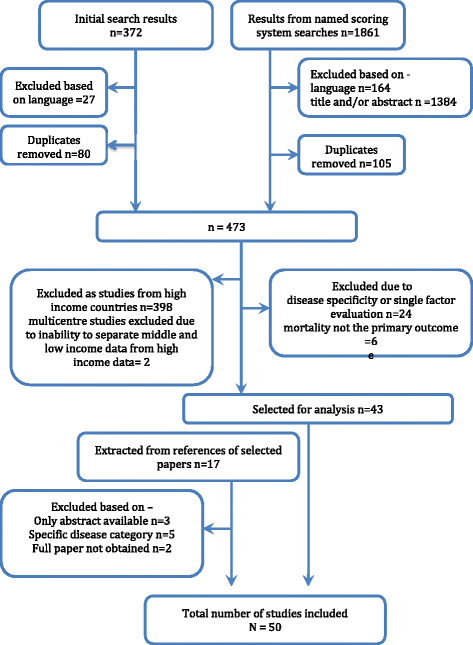Performance of critical care prognostic scoring systems in low and middle-income countries: a systematic review
- PMID: 29373996
- PMCID: PMC5787236
- DOI: 10.1186/s13054-017-1930-8
Performance of critical care prognostic scoring systems in low and middle-income countries: a systematic review
Abstract
Background: Prognostic models-used in critical care medicine for mortality predictions, for benchmarking and for illness stratification in clinical trials-have been validated predominantly in high-income countries. These results may not be reproducible in low or middle-income countries (LMICs), not only because of different case-mix characteristics but also because of missing predictor variables. The study objective was to systematically review literature on the use of critical care prognostic models in LMICs and assess their ability to discriminate between survivors and non-survivors at hospital discharge of those admitted to intensive care units (ICUs), their calibration, their accuracy, and the manner in which missing values were handled.
Methods: The PubMed database was searched in March 2017 to identify research articles reporting the use and performance of prognostic models in the evaluation of mortality in ICUs in LMICs. Studies carried out in ICUs in high-income countries or paediatric ICUs and studies that evaluated disease-specific scoring systems, were limited to a specific disease or single prognostic factor, were published only as abstracts, editorials, letters and systematic and narrative reviews or were not in English were excluded.
Results: Of the 2233 studies retrieved, 473 were searched and 50 articles reporting 119 models were included. Five articles described the development and evaluation of new models, whereas 114 articles externally validated Acute Physiology and Chronic Health Evaluation, the Simplified Acute Physiology Score and Mortality Probability Models or versions thereof. Missing values were only described in 34% of studies; exclusion and or imputation by normal values were used. Discrimination, calibration and accuracy were reported in 94.0%, 72.4% and 25% respectively. Good discrimination and calibration were reported in 88.9% and 58.3% respectively. However, only 10 evaluations that reported excellent discrimination also reported good calibration. Generalisability of the findings was limited by variability of inclusion and exclusion criteria, unavailability of post-ICU outcomes and missing value handling.
Conclusions: Robust interpretations regarding the applicability of prognostic models are currently hampered by poor adherence to reporting guidelines, especially when reporting missing value handling. Performance of mortality risk prediction models in LMIC ICUs is at best moderate, especially with limitations in calibration. This necessitates continued efforts to develop and validate LMIC models with readily available prognostic variables, perhaps aided by medical registries.
Keywords: Critical care; ICU scoring system; Low and middle-income countries; Model performance; Prognostic model; Resource-limited settings.
Conflict of interest statement
Ethics approval and consent to participate
Not applicable.
Consent for publication
Not applicable.
Competing interests
The authors declare that there are no competing interests.
Publisher’s Note
Springer Nature remains neutral with regard to jurisdictional claims in published maps and institutional affiliations.
References
-
- Juneja D, Singh O, Nasa P, et al. Comparison of newer scoring systems with the conventional scoring systems in general intensive care population. Minerva Anestesiol. 2012;78(2):194–200. - PubMed
Publication types
MeSH terms
LinkOut - more resources
Full Text Sources
Other Literature Sources


